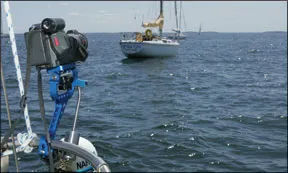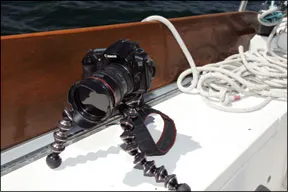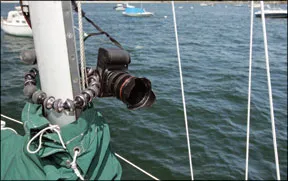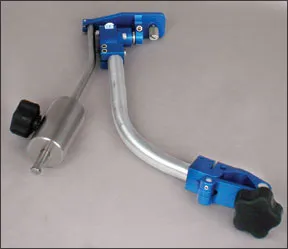Anyone who has ever tried to stabilize a camera aboard a moving boat knows how difficult it can be to keep the equipment dry, compose the shot, level the horizon, and keep your hands off the shutter button during long exposures.
Using a slow shutter speed (longer than 1/60th of a second) with a handheld camera, usually produces a blurry image, especially aboard a boat. Self-timers and wireless shutter triggers can make the job easier but are of little value if the camera isn’t securely mounted.

Photos by David Liscio
Given hull vibration, wave action, and the unevenness of the deck, setting up a stable work platform for the camera presents myriad challenges that marine photographers try to solve using a variety of camera mounts, three types of which Practical Sailor recently put to the task.
WHAT WE TESTED
Among the most popular gadgets for stabilizing a small video camera or digital SLR camera with a zoom lens is the venerable beanbag, similar to those photographers often use on African game safaris. The bags are typically fitted with a mounting screw that locks the base of the camera to the bag. Representing this category in our test was the Camo-Pro 7 beanbag from OmniPod.
Flexible devices that can be twisted around poles or tree limbs have been gaining popularity among the growing array of camera-stabilization tools. The San Francisco-based company Joby offers a line of flexible tripods that accommodate electronics in varying weights. The wimpiest models in this GorillaPod line are designed to hold steady a pocket-sized point-and-shoot, and the beefiest are meant to brace a professional DSLR camera with up to a 200-millimeter zoom lens attached. We tested the heavy-duty GorillaPod Focus and SLR Zoom.
A third method of camera-stabilization requires more specialized equipment, such as the precision line of camera mounts from Horizon True, and is geared toward the more serious shutterbugs and videographers. We tested three self-leveling Horizon True setups invented and sold by Jeffrey Mootz of Minnesota: the Counter Balance model, Pendulum model, and Multipurpose kit, which includes a mast mount. Horizon True also makes a featherweight version with a mount designed for Lasers and other small boats.
HOW WE TESTED
Practical Sailor
Each camera mount was tested aboard a Bristol 27 attached to its mooring and also while it was underway using auxiliary power across a smooth sea-ideal but rare conditions for a marine photographer. The products were set up on multiple spots on the boat: coachroof, stern pulpit, cockpit seat, mast, etc.
All were tested using a 20-ounce Canon 20D DSLR camera with a 20- to 35-millimeter lens (17 ounces) attached. At a combined 2 pounds, 5 ounces, the test load was relatively light by professional photography standards. By contrast, a more typical professional setup aboard a boat might pair a relatively heavy Canon 1Ds MKII series camera (3 pounds, 9 ounces) with a 200-millimeter Canon lens (3 pounds, 4 ounces), far heavier than the Canon combination we used to test the mounts.
Omnipod

The Omnipod Camo-Pro 7 is a durable beanbag with a flexible, nonskid bottom, a Velcro strap for securing it, and a threaded stainless screw centered for mating with the camera. Packed with polystyrene beads, the bag measures 11 inches long by 7 inches wide and 2.5 inches tall.
Bloggers offer up myriad suggestions for substitute camera platforms while on the go-from rice sacks to tube socks stuffed with grain to zipper-top plastic bags filled with native soil. The problem with most homemade beanbags is that they lack the quarter-inch screw that secures the bag to the camera, which means the camera could easily fall overboard. That isn’t a concern with the OmniPod.
During our trials, we lashed the bag to a stanchion and a grab rail on the coachroof. With the Velcro strap and the camera screwed to the bag, testers had no fear that the camera might fall overboard.
Simplicity, affordability, and stability are the Omnipods best features. However, the device offers no self-leveling capability, so as the boat heels, your camera viewfinder will follow suit. It also was the least versatile of the three types of mounts tested, but no tools are needed to attach the camera or to affix the mount.

The OmniPod Camo-Pro 7 beanbag can be purchased online for $74 and comes with a 30-day warranty.
Bottom line: The OmniPods limitations-especially the inability to self-level-should be recognized from the start. But its the second least expensive of the group and has few parts that can break or corrode. It gets the Practical Sailor Budget Buy.
Joby GorillaPods
Testers found the innovative Joby GorillaPod Focus and SLR-Zoom easy to use. Attaching the test camera via the quarter-inch stainless screw was simple, and the aluminum and plastic legs with rubber grips offer unlimited onboard mounting options. We wrapped their legs around the mast, a stanchion, the pulpits, and the grab rail. We also used them as mini tripods in the cockpit.
We had high hopes for both, given Jobys unique approach to mounting. The plastic-and-rubber SLR-Zoom, rated for 6.5 pounds, performed without a hitch during tests. However, the Focus failed with the Canon 20D DSLR and lens attached. One of the legs separated at the aluminum socket-plastic ball connection and could not be reattached.

The Focus is rated to support up to 11 pounds, considerably more than our 2-pound, 5-ounce test equipment. According to Joby, this type of defect is extremely rare and would be covered by their no-questions-asked return policy for factory defects.
Flexibility and versatility are the GorillaPods best features. They can be twisted like a Gumby doll into all sorts of configurations, enabling them to wrap around just about anything.
The GorillaPods do not adjust to the boats heel, and the hinged design presents multiple failure points, a characteristic that was highlighted by our test units demise.
The Focus can be found online for $99 and the SLR-Zoom for $50.
Bottom line: The GorillaPod concept is exceptional, in our opinion, but they still can’t help level your viewfinder.
Horizon True
The three Horizon True models we tested-the Pendulum, Counter Balance, and Multipurpose Mount kit-were designed originally for videography, but they also can be used with still cameras (with timers or remotes). All are made of stainless steel and anodized aluminum.

Testers found the heavy-duty Pendulum, rated to 15 pounds, to be superior to other camera mounts tested in terms of material construction and functionality. It is made for a professional DSLR camera with telephoto lens and waterproof housing or a waterproof prosumer video camera that weighs about the same.
The Pendulum is friction dampened, and is the suggested HT mount for still photography. The camera attachment point swings like a pendulum from a curved, vertical bar that attaches to the boat. No matter how the boat heeled during testing, the camera mount quickly leveled the horizon as it swung back and forth.
The Counter Balance model, rated for 4 pounds, uses hydraulic dampening; the manufacturer recommends it for offshore use. Since our tests, Horizon True released an updated version of this mount. The new Counter Balances hydraulic system allows for more positioning options and smooth transitions as the boat heels and pitches. For videographers, hydraulic dampening is the way to go-ESPN uses these mounts for filming regattas-though it may be overkill for the hobbyist still photographer.
The Multipurpose Mount, designed for lighter equipment, uses the same hydraulic system to level the camera, and comes with a Velcro mast-mount or a rail mount.
All of the Horizon True models are solidly constructed and relatively easy to attach with a series of built-in knobs and clamps. An Allen nut can be loosened with the supplied Allen wrench to adjust the tilt.

The downside of the Horizon True mounts is their price, which can range from $239 for the basic Pendulum setup to over $1,000 for the packages (with cameras). All Horizon True products come with a three-month, money-back guarantee.
Bottom line: If youre serious about marine photography or videography and have the budget to support the habit, the HT equipment is worth the investment.
Conclusion
Each of the three different mounting methods we tested has its pros and cons. The OmniPod was the most portable and least expensive of the bunch, plus its simplicity lends itself to a longer working life. It gets the Budget Buy nod.
Testers like the GorillaPods unique approach and unlimited versatility, but their multiple failure points and inability to keep the camera level hold them back. If you also plan to use it off the boat (hiking, biking, etc.), the $50 SLR-Zoom is worth considering.
The Horizon True equipment is undoubtedly superior to the other types of mounts, and its price reflects that. They were the least portable and had less versatility than the Focus, but they were the only test products that enable self-leveling, a key consideration in our testing.
Buyers who plan to use the HT mounts-or any attached to the pulpit-should also invest in a waterproof camera housing or waterproof equipment.
compared each product for function, durability, stability, ease of handling, and the ability to self-level the viewfinder.




































